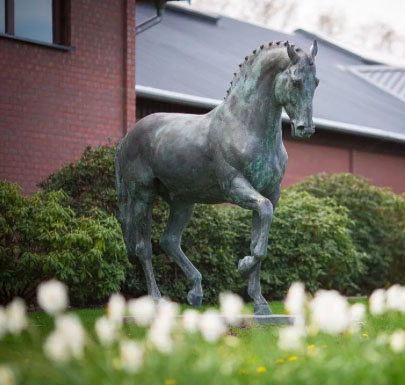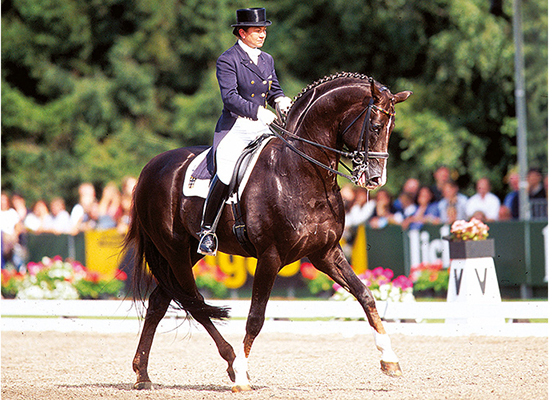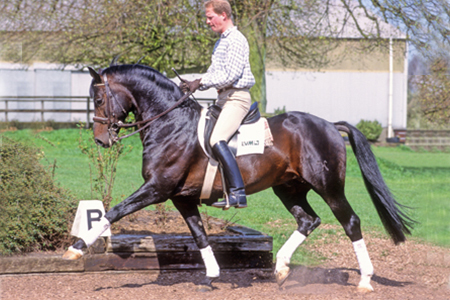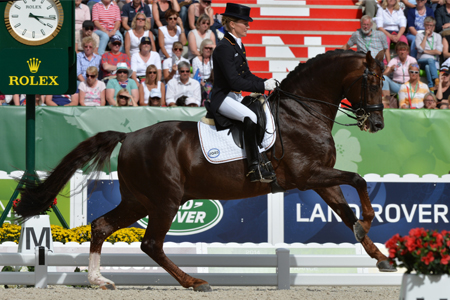DONNERHALL
1981 – 2006 172 cm Liver Chestnut Breeder: Otto Gärtner
There is no other stallion who has had such an impact on dressage breeding as Donnerhall…
Donnerhall was a colossus towering over the development of the modern dressage horse, siring great competitors but more importantly wonderful sires who themselves sired competitors and sires, and grandsons who were sires…
There is no other stallion who has had as much influence on dressage breeding as Donnerhall. The liver chestnut stallion was the first in so many areas. He was not however, the first dressage sire to successfully compete internationally, that honour belongs to the Swede, Gaspari.
Donnerhall was the founding stallion at one of the first truly glamorous Oldenburg private studs – Grönwohldhof. It was a trend that was to strengthen and grow as the private studs that reflected the affluence and taste of their mega-rich owners mushroomed. Grönwohldhof with its mill pond and waterwheel, its beds of azaleas, and picture perfect paddocks with foals with neatly trimmed tails, threw out the challenge taken up by later establishments like Gestut Famos where the magnificence of the setting overwhelmed the breeding operation.
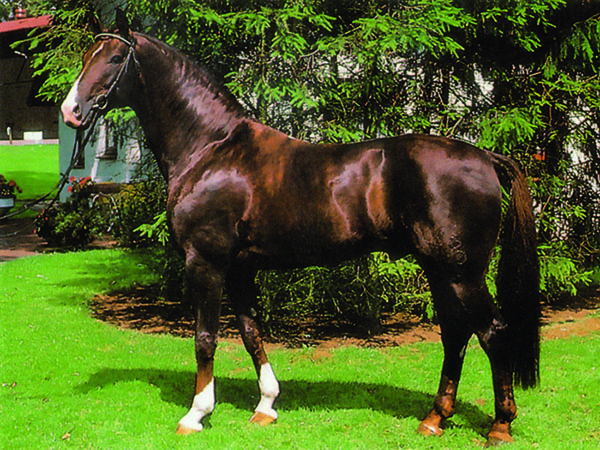
Donnerhall at home in the Grönwohldhof gardens – Werner Ernst image
Sadly of recent years, the trend has been reversed, and many of those famed Oldenburg studs – including Grönwoldhof – have disappeared.
Beautiful as Grönwohldhof may have been, it was also brilliantly designed, and laid out.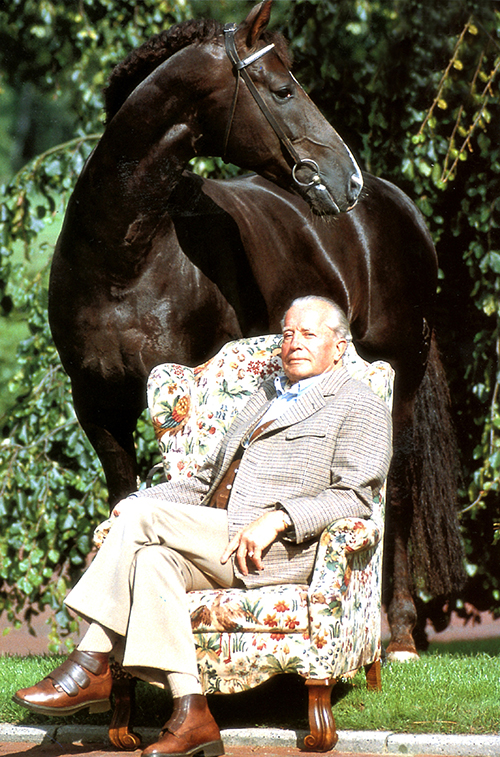 The founder, who was confined to a wheel chair, could observe all of the operations of the establishment via closed circuit vision in the central control room, from which the various wings of the main stud building fanned out.
The founder, who was confined to a wheel chair, could observe all of the operations of the establishment via closed circuit vision in the central control room, from which the various wings of the main stud building fanned out.
But Grönwohldhof was as important as a rider training centre as it was a breeding oasis.
At the heart of the stud, there was the round court at the centre, usually packed with the luxurious tack boxes of visiting teams, celebrity riders, and the rich and hopeful. Off to one side in the centre of the riding hall, sat Herbert Rehbein, like some oriental pasha, surrounded by his followers, as he directed the activities of the dozen or so riders in the school at any one time.
And what riders he produced! Riders like Martina Hannöver, Ingo Pape, Susan Draper (now Pape), Falk Rosenbauer – plus visitors from all over the world. The whole Swedish team was there much of the time. The Americans were there, the Finns, the English.
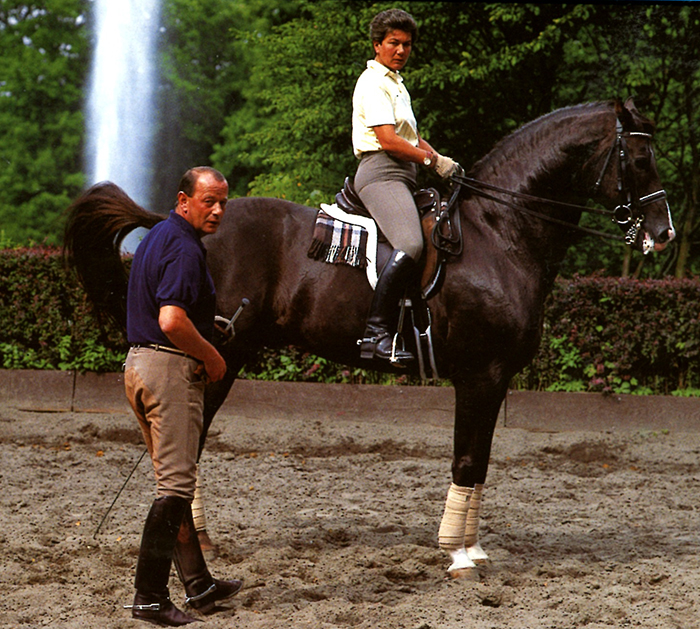
The threesome – Herbert, Karin and Donnerhall…
And while Grönwohldhof was a magnet for riders, Donnerhall, as one of the first super star stallion competitors, was a magnet for mare owners…
It must be admitted that Donnerhall hardly comes from a ‘good family’. His sire, Donnerwetter disappeared into the wilds of the United States in the mid seventies, but while there were a couple of Donnerwetters ‘gracing’ the German dressage arenas, they were pretty ugly, untalented creatures.
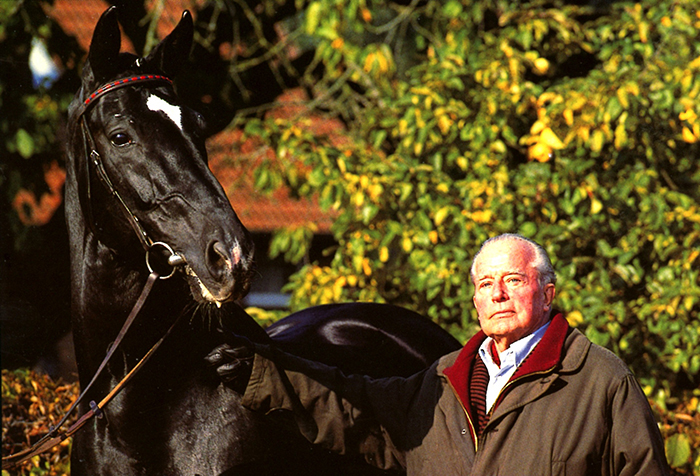
Donnerwetter
Donnerhall’s famous rider, Karin Rehbein noted in an interview I conducted in 2000, “There are a lot of Donnerwetters who have a little similarity to him it is difficult to get another just like him,” said Karin, “Look at Donnerhall’s full-brothers, you couldn’t compare any of them to him. In appearance, in everything about him, the full brothers don’t come anywhere near Donnerhall. There were even two brothers who competed Grand Prix, but they were nothing compared to Donnerhall. They don’t even look the same, don’t move one little bit the same.”
It’s interesting, that all the super stallions who made up the dressage big three, Donnerhall, Weltmeyer and Rubinstein, had full siblings who were very ordinary. Indeed one day, long ago, I was offered Rubinstein’s full-brother for very little money, but was not even tempted, he moved like a startled chook.
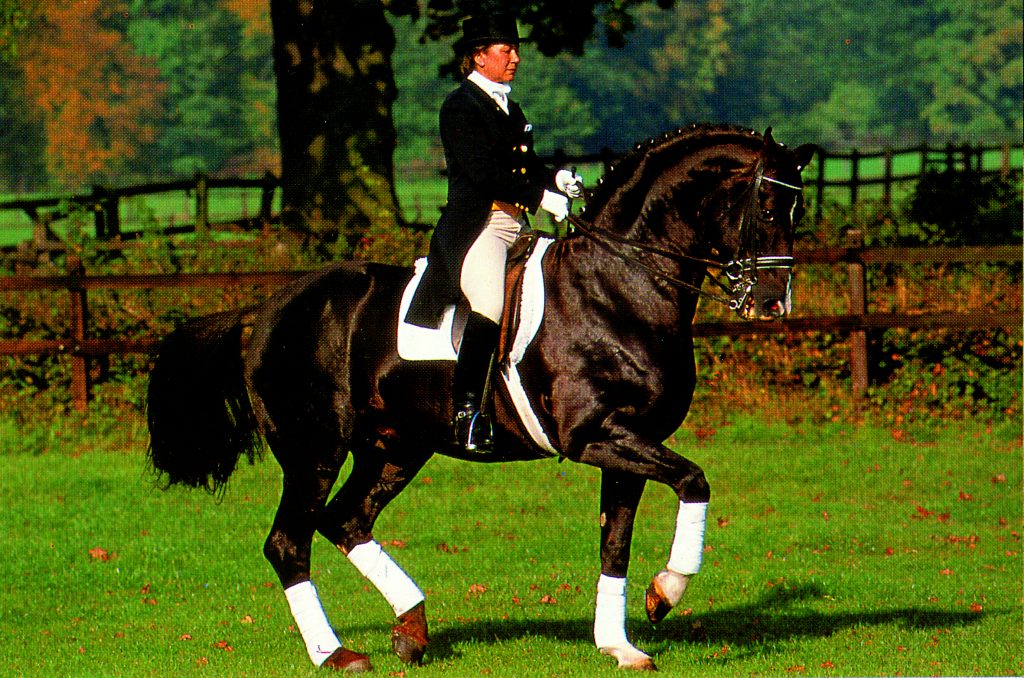
To see Donnerhall compete was to marvel at the imposing power of the big stallion, but surprisingly, even though Mrs Rehbein is not very tall, and certainly not very big, the ride he gave her was ‘very good’.
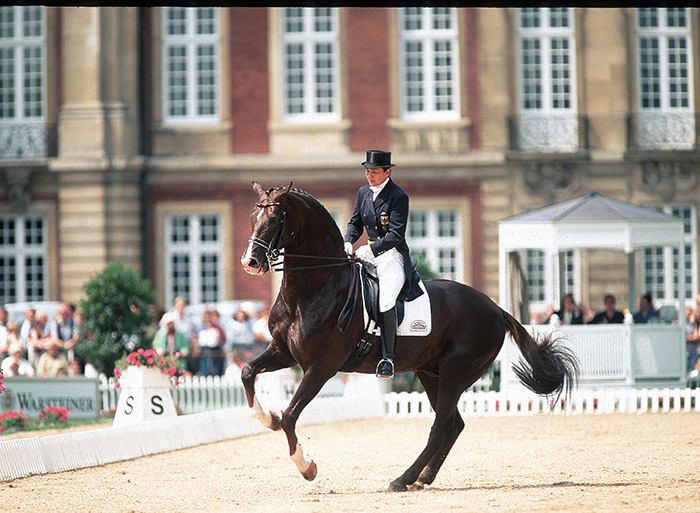
“He was very soft. Sometimes you had to hold him a little bit through, but you have to do that with every horse.”
Donnerhall’s talent was apparent right from the start, and he scored 131.92 to be second in his performance test at Adelheidsdorf in 1984. Donnerhall’s competition career is the stuff of legend. He won many Grand Prix, Grand Prix Specials and Freestyles for Mrs Rehbein.
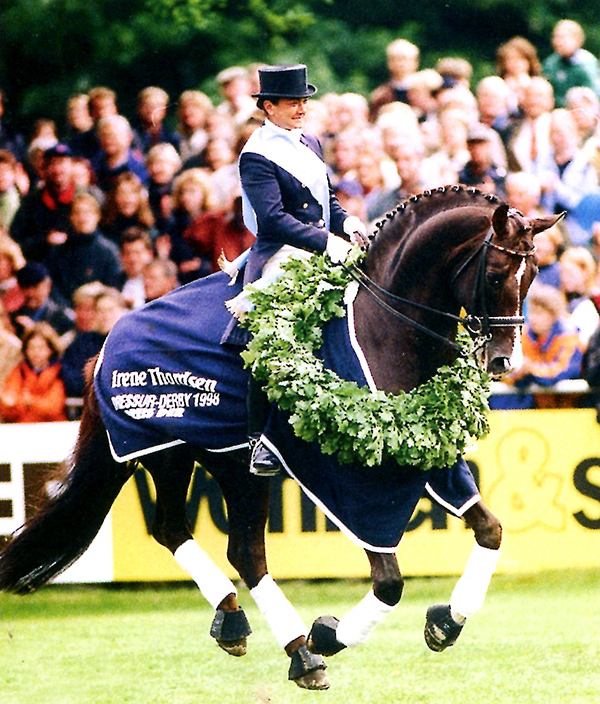
In 1994, Donnerhall was individual bronze medallist (and team gold medallist) at the 1994 World Championships at The Hague. Donnerhall won the European World Cup Freestyle League final standings twice, in 1997 and 1998. He retired from competition in 1998.
What Donnerhall seems to give to his offspring, is a trainability and a strength to handle the more collected work, even if their natural paces are not so spectacular. It would seem that the mix of Donnerhall and a large drop of ‘blood’ (Thoroughbred that is) in the dam is more likely to produce competition horses. But it can’t be emphasized enough that what distinguished Donnerhall from the two others in the big three, was his ability to establish a stallion line.
Davignon and Ingo Pape
Perhaps the most successful Donnerhall son, is De Niro who started competing at Grand Prix level at the tender age of seven. De Niro is out of an Akzent II mare, and Burchard Wahler, the man who bought De Niro at the Hanoverian licensing, when Dr Bade failed to take him in the Celle lot, as was his right in those days, says this was a deliberate choice:
“I love to buy the Donnerhall blood but I don’t like the very popular Donnerhall / Pik Bube cross – very heavy big horses, and I didn’t like that so much because I am from the other side, from the Trakehner side and I like more an elegant horse. I really liked De Niro, because he was out of a mare with Wiesenbaum / Akzent breeding. Akzent is through Absatz, Trakehner, Wiesenbaum is from Thoroughbred – so in my opinion, this was a very interesting bloodline.”
De Niro went on the assume the mantle of his sire dominating the WBFSH dressage sires rankings year after year.
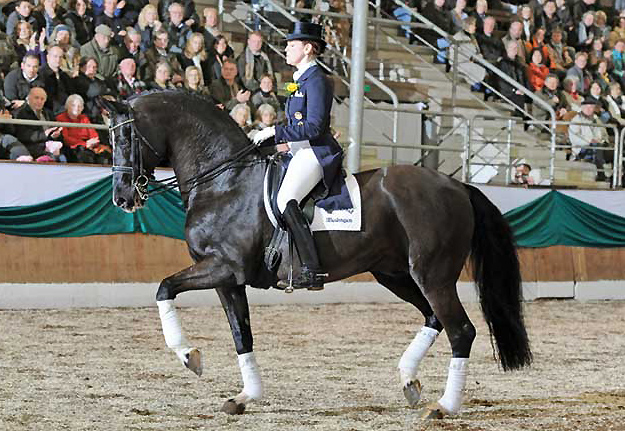
De Niro, dominating the WBFSH rankings year after year and school-master for sixteen year old Therese Wahler
The 2011 Hanoverian Stallion book (the last in which he appears) records that Donnerhall has had 998 competitors, 840 dressage competitors (226 at advanced level) – and even 97 in the jumping ring – for total prizemoney of €2,137,490. Far and away the most successful of these progeny has been the mare, Donatha S, who won €174,242 followed by Don Schufro with winnings of €109,257. At that point, there were 40 horses with dressage winnings of more than €10,000.
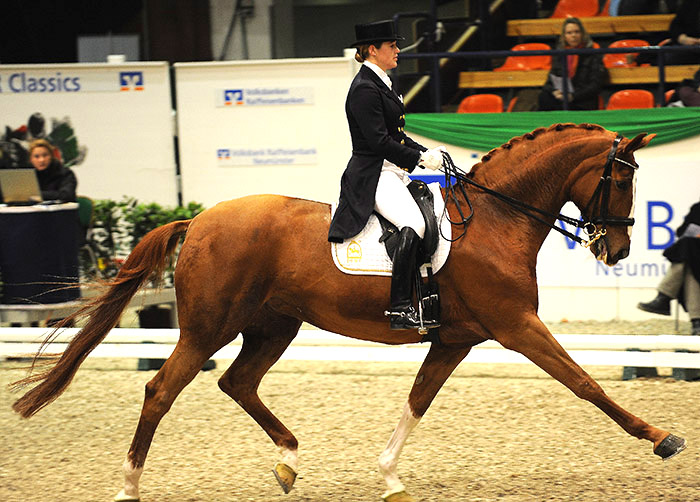
Donatha S and Ellen Schulten-Baumer
Donnerhall had FN dressage ranking of 150, jumping, 77. His Hanoverian ranking is 158 for dressage and 75 for jumping. He was the sire of 50(!) licensed sons at that stage.
Donnerhall was ranked fifth on the WBFSH rankings for 2013 based on FEI recorded performances, with most of his points earned by three of the world’s top ten – Damon Hill, Donnperignon and Digby – with one son, De Niro, ranked number one, and another, Don Schufro, in sixth place.
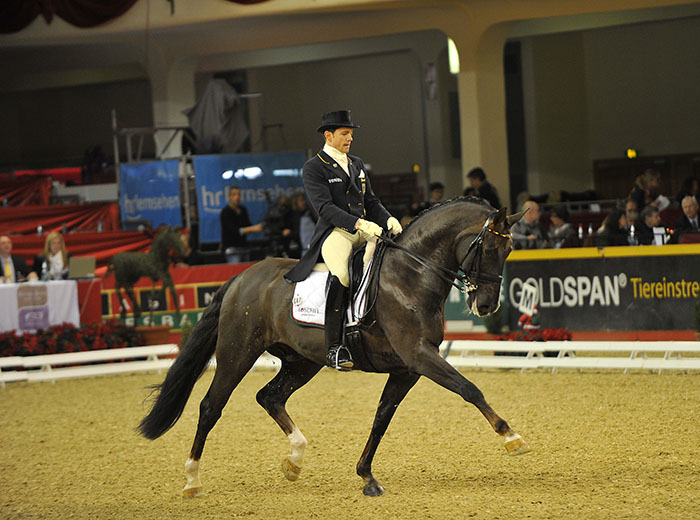
Donnperignon and Christoph Koschel
The ‘D’ line horses were out in strength at the London Olympic Games. By Donnerhall himself, we find three, Donnperignon, Damon Hill and Digby. De Niro provided Dablino, Donnerfee and Desperados, then we have D’Niro (by D-Day), Diva Royal (by Don Frederico), Don Auriello (by Don Davidoff) and Dorina (by Don Schufro).
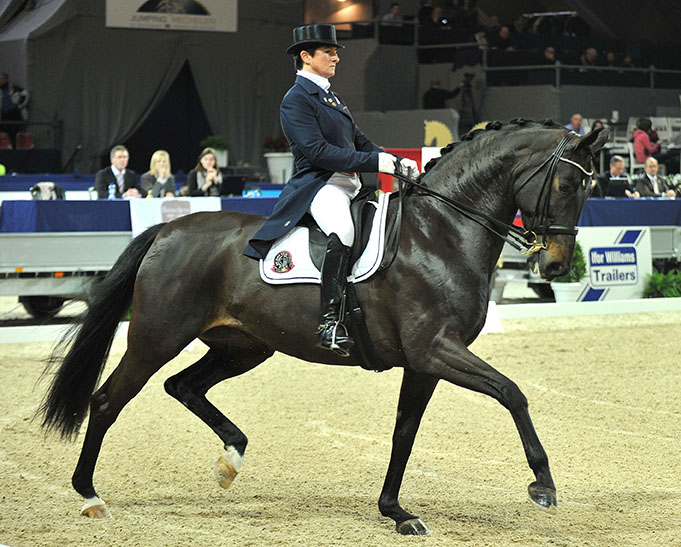
Donnerfee
Looking at the start list for the dressage at the WEG in Normandy, the first thing we observe – yet again – is the outright dominance of the Donnerhall line. He, himself, was represented by four competitors, a total only matched by his son, De Niro. Donnerhall was further represented by two sons, Donnerschlag and Don Cardinale. Another son, Don Gregory was represented by two of his sons, Don Davidhoff and Don Ruto. De Niro’s son, Danone I was also the sire of one competitor. That’s thirteen D-liners out of 103, almost 13%.
In the Freestyle, the percentage of D’s rose to 46.66 (7 out of 15). Three by the grand old man himself, the rest by four of his sons.
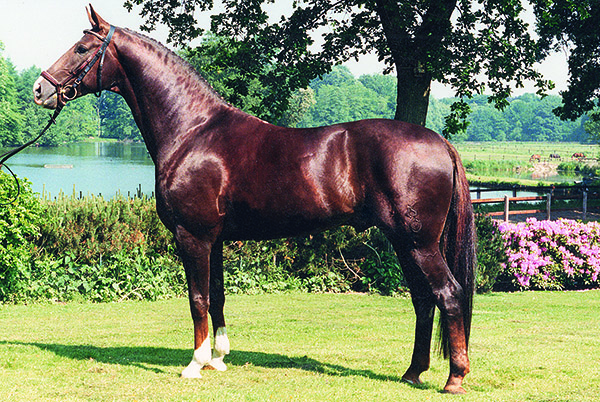
I asked Jan Tönjes who before he became a journalist had an honest job working with the Oldenburg Verband, Why did Donnerhall became such a dominating force? How? His dad really only made one horse, his full brothers were duds…
“It has in my opinion, two reasons. First of all, and it is in the breeding, he is a very solid type of horse, with this third dam still belonging to the old Oldenburg Coach type. When he was certified, even then, people thought he was not the modern type. He had a bit a head, but always loads of expression in his eye, his croup was not the ideal but these coach horses were two things: they were eager to work every day, they had a super attitude, which always helps, rideability is always something you would associate with ‘D’ rather than ‘W’. Plus, they had to stay sound conformation-wise. I can’t say that Donnerhalls are the soundest horses in the world but look at some of the other lines – you buy them and then you keep them doing the job but not too much, with the Donnerhalls you can ride them, they are tough guys, and again, maybe you don’t need to train them as much as the others, so they don’t have the mileage with helps their soundness again. These are the two things that I think make the Donnerhall line the complete package.”
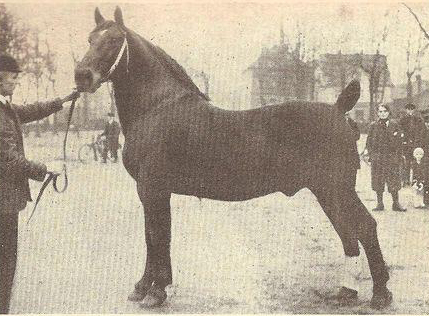
Gruson born in 1917. Donnerhall has six crosses of the stallion…
Ludwig Christmann points again to toughness. When I asked him about the success of De Niro, he had this to say:
“I think you should probably talk to the riders and trainers, I think it is the minds that they like. When I talk to Mr Sprehe about Desperados and he says the horse is always fit, even if it is 35 degrees like in Rio, he always does his job. They have the talent for collection and the higher movements, but it is the mind that makes them so special.”
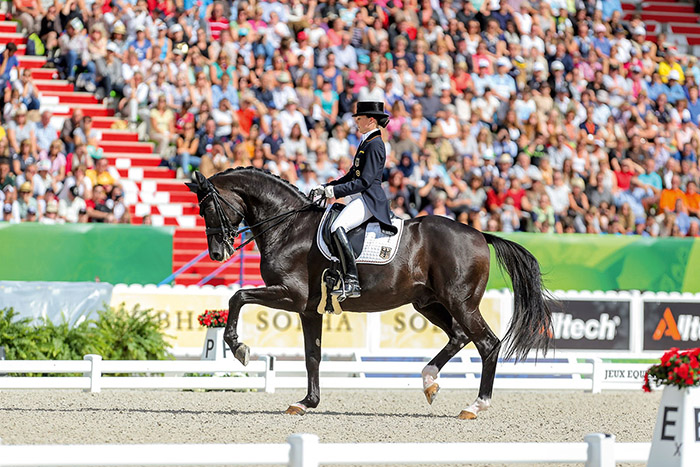
Desperados – when the going gets tough…
Back in 2012, when I interviewed the then assistant breeding director of the Oldenburg Verband, Katrin Burger, she made much the same point:
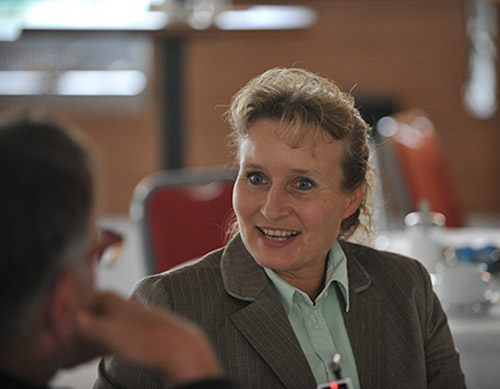
“De Niro was one of the few stallions to come back. He had an outstanding first foal crop, some really expensive auction foals and then everyone was in deep shock when they were three-year-olds, because they weren’t as nice as they had been as foals. They changed, they were a little bit flat – a good trot, but a lot of them had problems in canter. This is a difficult issue until you go to Grand Prix because there if they do one times changes, but the canter is flat, no one cares, and there is no question that a lot of De Niros go to Grand Prix, and that is why he came back and the breeders started to use him again.”
Damon Hill, dressage superstar
When we look at the 2021 Hanoverian rankings we see that the influence of the ‘D’ line has not disappeared, although its current status is rather dependent on stallions that are no longer with us. 2021’s highest ranking of 144 is shared by Don Schufro and Dimaggio. Don Schufro died in 2020, Dimaggio died in 2015 but his influence is still being felt.
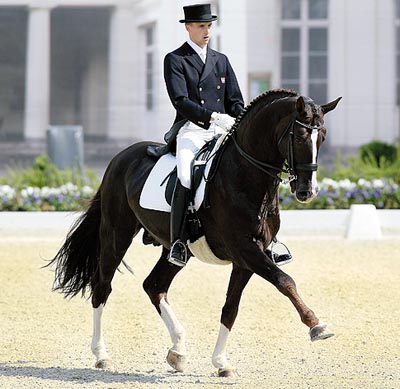
Don Schufro
At Frankfurt 2022, Dimaggio was the only stallion with more than one finalist in the prestigious Nürnberger Burg-Pokal – he was the sire of finalists, Del Curto (out of a Wolkentanz II mare) and Da Costa (Coriander / Amigo xx).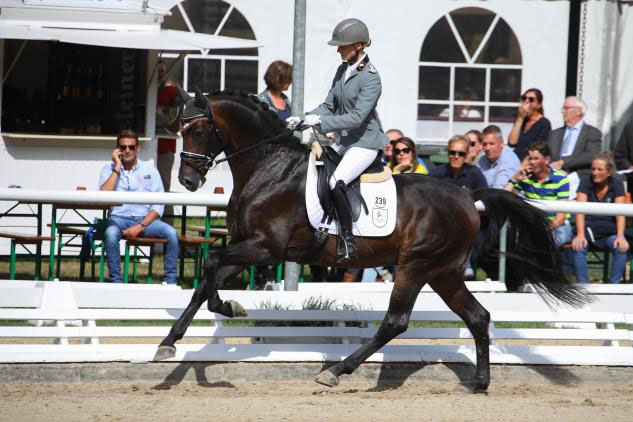
Da Costa
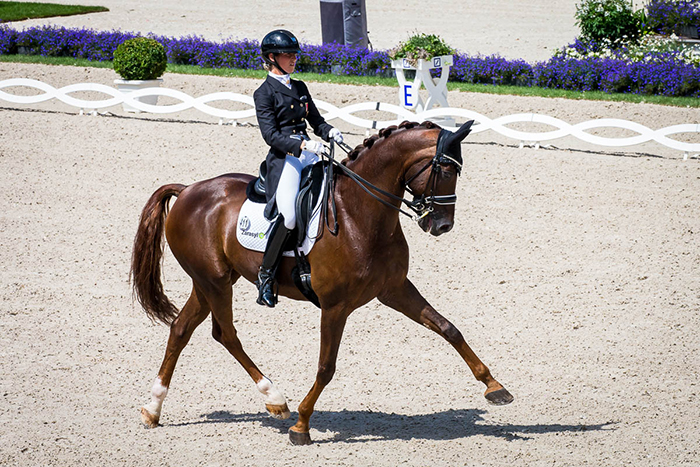
Del Curto
His sire, Don Primero was the first stallion star by Donnerhall. Don Primero was the Champion 5 year old Dressage horse at the 1990 Bundeschampionate and went on to compete at Grand Prix level with Karin Rehbein. Don Primero is a full brother-in-blood to the more famous stallion and Grand Prix performer, Don Schufro (whose dam Fiesta is a full sister to Don Primero’s dam Fantasia).
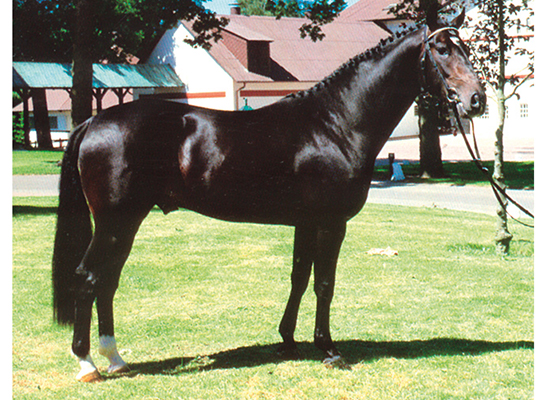
Don Primero
For a number of years Don Primero headed both the Hanoverian and FN dressage stallion rankings, although perhaps partly because he was based in Sweden for much of his career, he slipped down the list.
I caught up with Hanoverian breeding expert, Ludwig Christmann at Frankfurt and asked about DiMaggio…
Let’s talk about Dimaggio, he has been an amazing stallion, especially as he spent so much time in England where I don’t think he would have had so many mares…
“But from England he came to Böckmann. Actually I was part of the licensing commission who licensed him in England when I was there for the British Hanoverian Horse Society, he was not a super stallion type but he was so amazing with three super gaits, walk, trot, canter and this is what I think he always passes on. Always supple.”
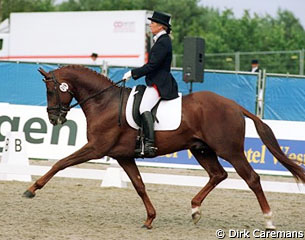
DiMaggio
“When I came back to England at the Hanoverian show he always had super foals, and I said to the English, ‘this is a world class stallion’. Conformation-wise sometimes the necks are a little low set – but his major point was the quality of gaits.”
“Later he came to Germany and placed at the Bundeschampionate with Hans-Heinrich Meyer zu Strohen, and he did a good performance test. Then he went on to win the first World Young Horse Championship as a 5yo with his British owner, Suzanne Lavendera.”
“There are so many great sons of Donnerhall, for me Donnerhall was really the stallion that changed dressage breeding, it is amazing what he produced, especially at the time, that showed great collection – piaffe, passage, and rideability, mind, he changed dressage breeding.”
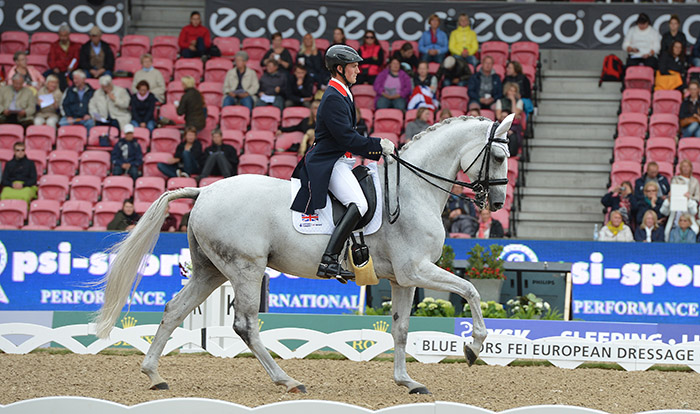
Half Moon Delphi
Dimaggio’s most successful offspring was the British bred Grand Prix horse Half Moon Delphi, who won team gold with Michael Eilberg at the 2013 European Championships and team silver at the 2014 World Equestrian Games. Dimaggio has sired 30 Grand Prix competitors, and they still keep coming seven years after his death in 2015.
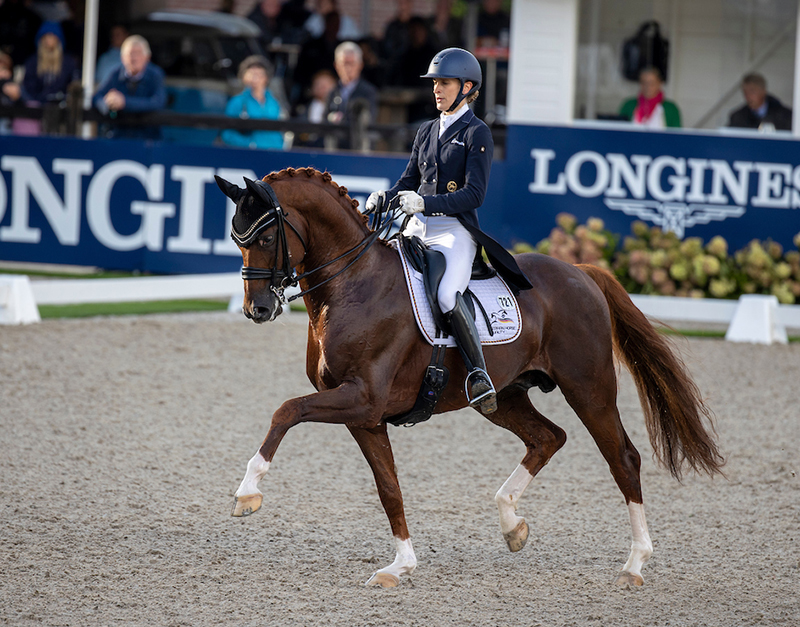
Destello
One of the stars at the 2022 World Young Horse Championships was the reserve champion of the Seven Year old horses, Destello who is by Dimaggio out of a mare by Fürst Fugger.
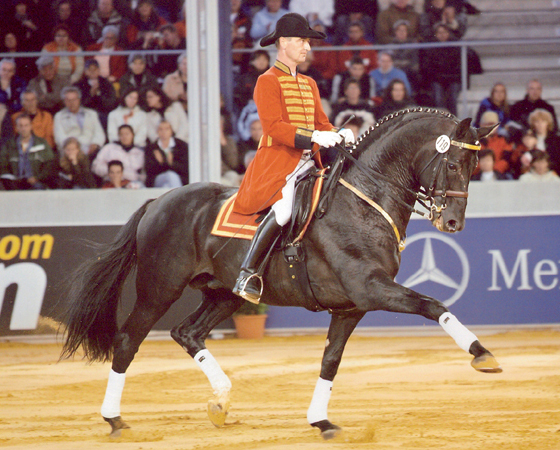
Don Frederico, one of the first ‘D’ Line stallions at Celle
And now, for some at least, the elephant in the room, WFFS, there seems little doubt that Donnerhall was positive, like his sons, Don Schufro, and the first two stallions taken into the Celle stallion band, Don Frederico and Don Vino (both out of Consul mares). Luckily he lived before the age of facebook hysteria and was able to play an enormous role in the creation of the modern dressage horse…
